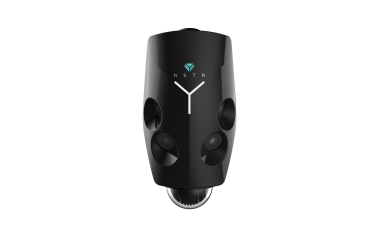Fire is Fire and Security is Security
Ian Moore was one of the true pioneers in the field of Video Smoke Detection. Now, he is the CEO of Fire Industry Association. Lisa Schneiderheinze, Editor of GIT SECURITY, had the...

Ian Moore was one of the true pioneers in the field of Video Smoke Detection. Now, he is the CEO of Fire Industry Association. Lisa Schneiderheinze, Editor of GIT SECURITY, had the opportunity to ask him about earliest and latest developments.
GIT SECURITY: Looking back when you brought Video Smoke Detection (VSD) to the market many years ago, what was the Fire Safety Situation back then? And what was the initial ‘spark’ to converge security equipment with fire safety products?
Ian Moore: It was in an era (mid-late 90’s) of the explosion of digital signal processing, specifically towards image processing. There were numerous algorithms around to detect motion within the scene of view from a CCTV camera which rapidly became a de facto offering as an intrusion “bolt-on” through DVRs and/or smart cameras etc.; by today’s standards crude, using a percentage contrast change pixel by pixel. There were even a few basic detection algorithms looking at the motion patterns of smoke but none that were much more than conceptual or laboratory run research projects. The only fire safety situation then that allowed new technology to be used was the acceptance of engineered solutions for areas that could not be suitably covered by prescriptive traditional means i.e. smoke detectors, beam detectors etc. However, designers would rarely “put their neck out” on new and uncertified products. In the world of integrated fire and security systems, this was the first product that sat firmly in the middle utilising the equipment of a CCTV security system for the purpose of fire detection.
What are the newest developments in Video Fire Detection?
Ian Moore: Technological advances in computer processing power and memory have given us more opportunities to increase the performance and usages of pretty much the same technology. Faster processing allows us to make many more calculations with the same data, higher frame rate analysis and higher resolution of camera images gives us more accurate data. IP networks and smart cameras (on-board processing) allowing decisions to be made at the camera (certainly different from the initial days of using video grabber boards in a PC using a DOS operating platform!) boosts system design options. There is often more than smoke emitted from a fire (or potential fire). Systems that implement a range of detection such as smoke, flame, visible, heat (through infrared) audible, gases (through spectral analysis) etc. will give a wider range of detection and the potential to detect fires earlier and reduce false alarms. A self-learning algorithm could help build up a history of what to expect at certain times of day (lighting angles/intensity, how busy is the scene, processes etc.) however how this fits into standards right now is difficult to see. There are a number of quality companies around the World that work on this technology, some investing heavily for nearly 15 years. I hope that they continue to have the vision (excuse the pun) of what it can be in the future once the performance standards have been agreed and can then be an accepted main stream form of detection.
What are the main challenges when integrating video-based Fire Detection into a security, building management or alarm system?
Ian Moore: A lot of it is mind-set i.e. fire is fire and security is security. There are rightfully fears of corruption of signals, especially over IP networks and, although these can be secured, the reticence remains. Another big reason is product/system approvals which in many cases do not allow the usage in combined systems. Even though the technology has been around for over 20 years, it is still considered to be in its infancy.
What are the benefits of video-based Fire Detection in comparison to regular Fire Detectors?
Ian Moore: Without giving a sales pitch, there are plain facts to state:
- Faster detection as the camera is usually looking at the source of the fire therefore not waiting for emissions to reach a detector.
- You can use an existing CCTV system therefore costs can be reduced (plus limited or zero interruption to the site during installation).
- Visual verification of alarm. With an ever increasing requirement for the confirmation of an alarm signal (be that fire or security), this is a key factor.
- Large area of coverage. It is not an exaggeration to state that one camera can cover the same area of coverage as dozens of point detectors leading to lower equipment costs and lower installation costs. This also works at all heights so stratification becomes less of an issue.
- Access. The cameras can be fixed in an accessible position (for installation and maintenance) and “look” into an inaccessible area. There are many examples of this.
- Complex areas where standard detection can detect as normal but will potentially false alarm due to unwanted smoke etc. Video fire detection can accept or ignore some areas that are problematic.
However for all the positives there are a number of negatives in using this technology. Here are a few facts on this particular point:
- Lighting. If your cameras are dependent on light, then it is important that the lights have back up power systems (e.g. batteries) to ensure the integrity of the system is maintained.
- Background. Should white smoke be in front of a white background (or of course black on black) then there is not much chance of the camera defining the smoke. This may (and we have had to do this previously) lead to painting the background to give strong contrast difference between the expected colour of the smoke and the background colour.
- Unsuitability for small areas (technically and commercially).
- Unproven technology for many. A designer can be questioned on the option of using video smoke detection should something go wrong.
As an overall summary, how do you see the future of camera based fire detection?
Ian Moore: When I first started with video smoke detection I believed that it was the future to nearly all fire detection needs – certainly optimistic. I continue to believe that it is better than many think and should be used more often in a number of areas. I am also aware that it could be a life safety system and therefore it has to be robust and accurate (better than other options).
There are many barriers in bringing new technology into our industry; some are justified and some are not. Some of those barriers are now being broken down with the inclusion of a number of codes, standards and approvals such as ISO/TS 7240-29:2017 and a number of guides such as the FIA post from time to time (free to download from our website). Hopefully it will become a readily recognised addition to the range of detection we currently have.
Certain applications lend themselves naturally to camera based fire detection; with more slowly being accepted. The balance is between early and effective detection against false alarms (the same for every system). Applications that are clearly suitable right now and are hard to argue against are large voluminous areas such as power station turbine halls, hangars etc.
To finish let me put a vision to you (the art of the possible); imagine a fisheye lens smart camera in the centre of a room (covering every corner), make it wireless, option of infrared when no lights are on, use the light and wireless power in the room to top up the charge – that’s the sensor. The software can then detect smoke, heat (through distortion), change the temperature in the room by analysing an image on the wall that changes with heat (no need of a thermostat controller in the room), virtual tripwires (no need of PIR detector), facial recognition (confirmation of access rights), leak detection, anti-distortion on the viewed image for general surveillance etc. We’re a long way from this being installed, but all of it can be done right now – just imagine…












